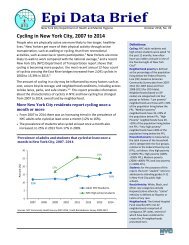2013-dot-sustainable-streets-lowres
2013-dot-sustainable-streets-lowres
2013-dot-sustainable-streets-lowres
You also want an ePaper? Increase the reach of your titles
YUMPU automatically turns print PDFs into web optimized ePapers that Google loves.
MOBILITY63%increase in bikevolumes on 9thAvenue since 2007CYCLINGWhere it was a fairly intimidating place to bicycle just a few yearsago, New York City has become the most bike–friendly big city inAmerica. New Yorkers voted with their pedals for the increasinglyinterconnected bike lane network and the design innovation thatcreated protected bike lanes on major avenues. CitiBike removedadditional barriers for those who face problems storing or parkingtheir own bikes, and has fully unlocked New York’s potential as acycling city.New York City’s density, interconnected street networks and flatterrain have always given it the potential to be an ideal bicyclingcity. PlaNYC and Sustainable Streets were both crystal clear in theirintentions to finally leverage this latent advantage. The policies saidclearly that city <strong>streets</strong> would become increasingly welcoming tobicycles—PlaNYC set the goal of adding 200 miles of new bike laneswithin three fiscal years, while Sustainable Streets looked ahead to adoubling of documented bicycle volumes on key routes.To help spur cycling, NYCDOT’s strategy has been to develop bikelanes as a network that is useful for the trips New Yorkers need tomake, rather than tucking disconnected bike lanes away in disparateareas. Much of the post–2006 network improvements were initiallyfocused in the lower half of Manhattan and the northern half ofBrooklyn where cycling rates were relatively high, where it wasplausible that additional people would respond to improved cyclingconditions. Tremendous increases in cycling volumes in these areasin 2007–2009 supported the strategy. DOT was subsequentlyable to expand the network on this basis of very strong usage andresponse. In more recent years, very strong additions have beenmade to the network across the City, including the South Bronx,Midtown Manhattan and Western Queens.Design innovation has been a critical factor in making the cyclingnetwork attractive to more people. In 2007, NYCDOT pioneeredthe practice of protecting bike lanes by setting them off frommoving vehicle traffic with “floating” parking lanes that were nolonger located along the physical curb. Manhattan’s 9th Avenuesaw the first of these projects, which also features a bicycle signalphase where cross–<strong>streets</strong> turned across the bike lane. The 9thAvenue approach quickly won acclaim—including the Institute for84Chapter 7: Streets for All: Improving Choices for Short Trips



